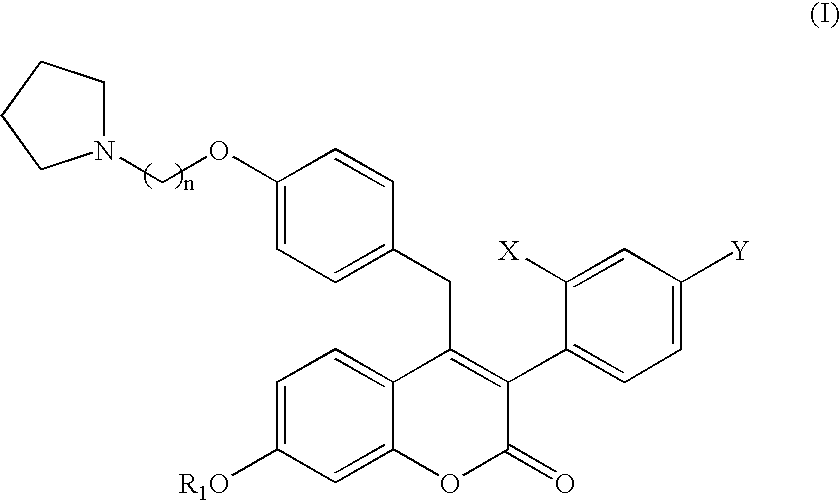Benzopyranone compounds, compositions thereof, and methods of treatment therewith
a technology of benzopyranone and compounds, applied in the field ofbenzopyranone compounds, can solve the problems of limited treatment, increased cancer risk, fragile bones,
- Summary
- Abstract
- Description
- Claims
- Application Information
AI Technical Summary
Benefits of technology
Problems solved by technology
Method used
Image
Examples
example 1
3-(2-CHLORO-4-TRIFLUOROMETHYLPHENYL)-7-HYDROXY-4-(4-(2-PYRROLIDIN-1-YL-ETH-OXY)-BENZYL)-CHROMEN-2-ONE
[0115] A. (2-Chloro-4-trifluoromethylphenyl)-acetic Acid 10
[0116] A solution of LiHMDS in toluene was prepared by the addition of n-BuLi (357 mL of a 1.6 M solution in hexanes, 571 mmol) to a cold (-78.degree. C.) solution of HMDS (120.5 mL, 571 mmol) in toluene (700 mL). After 30 min, the reaction mixture was allowed to warm up to 10.degree. C. over 1 h. The solution was then transferred via a cannula to a flame-dried, three-neck flask under N.sub.2 containing Pd.sub.2 dba.sub.3 (4.18 g, 4.57 mmol) and (2'-dicyclohexylphosphanylbiphenyl-2-yl-)-dimethylamine (3.77 g, 9.59 mmol). The mixture was stirred for 15 min at 15.degree. C., cooled to -10.degree. C. and t-butylacetate (70.5 mL, 525.4 mmol) was added dropwise. After 10 min, 3-chloro-4-iodobenzotrifluo-ride (70 g, 228.4 mmol) was added and the reaction mixture was warmed up to 28.degree. C. After stirring at this temperature for ...
example 2
3-(4-CHLORO-2-TRIFLUOROMETHYLPHENYL)-7-HYDROXY-4-(4-(2-PYRROLIDIN-1-YL-ETH-OXY)-BENZYL)-CHROMEN-2-ONE
[0124] A. (4-Chloro-2-trifluoromethylphenyl)-acetic Acid 14
[0125] A solution containing 4-chloro-1-iodo-2-trifluoromethylbenzene (14.98 g, 48.9 mmol), Bu.sub.3SnCH.dbd.CH.sub.2 (15.7 mL, 53.7 mmol) and (Ph.sub.3P).sub.4Pd (2.26 g, 1.955 mmol) in anhyd toluene (200 mL) was deoxygenated using vacuum-N.sub.2 flush (3.times.). After refluxing the reaction mixture for 17 h, it was cooled to 0.degree. C. and a solution of disiamylborane-methyl sulfide complex in toluene (.about.1.95 M, 47 mL) was added dropwise over a period of 5 min. The disiamylborane-methyl sulfide complex solution was prepared by adding 2-methyl-2-butene (26 mL, 245 mmol) to a cold (0.degree. C.) solution of borane-methyl sulfide complex (11.6 mL, 122.3 mmol) in anhyd toluene (25 mL) and stirring the resultant mixture at r.t. for 2 h. The bath was removed and the reaction mixture was stirred at r.t. for 3 h. After that...
example 3
3-(2,4-BIS-TRIFLUOROMETHYLPHENYL)-7-HYDROXY-4-(4-(2-PYRROLIDIN-1-YL-ETHOXY-)-BENZYL)-CHROMEN-2-ONE
[0133] A. 3-(2,4-bistrifluoromethylphenyl)-4-(4-hydroxybenzyl)-7-methoxych-romen-2-one 18
[0134] This compound was prepared using the methodology described above in Example 1B. The resultant residue was purified using flash chromatography (silica gel, 1:1 to 3:2 Et.sub.2O:hexanes) to provide the title compound as a yellow foam showing: .sup.1H NMR (300 MHz, CDCl.sub.3) .delta. 8.03 (s, 1H), 7.78 (d, 1H, J=8.0 Hz), 7.42 (d, 1H, J=8.8 Hz), 7.36 (d, 1H, J=8.0 Hz), 6.90 (d, 1H, J=2.5 Hz), 6.84 (d, 2H, J=8.5 Hz), 6.78 (dd, 1H, J=2.5, 8.8 Hz), 6.70 (d, 2H, J=8.5 Hz), 4.76 (s, 1H), 4.01 (d, 1H, J=16.0 Hz), 3.88 (s, 3H), 3.57 (d, 1H, J=16.0 Hz).
[0135] B. 3-(2,4-bistrifluoromethylphenyl)-7-methoxy-4-(4-(2-pyrrolidin-1--yl-ethoxy)benzyl)-chromen-2-one 19
[0136] This compound was prepared using the methodology described above in Example 1C. The resultant brown foam was purified using flash chromatog...
PUM
| Property | Measurement | Unit |
|---|---|---|
| temperature | aaaaa | aaaaa |
| temperature | aaaaa | aaaaa |
| body weight | aaaaa | aaaaa |
Abstract
Description
Claims
Application Information
 Login to View More
Login to View More - R&D
- Intellectual Property
- Life Sciences
- Materials
- Tech Scout
- Unparalleled Data Quality
- Higher Quality Content
- 60% Fewer Hallucinations
Browse by: Latest US Patents, China's latest patents, Technical Efficacy Thesaurus, Application Domain, Technology Topic, Popular Technical Reports.
© 2025 PatSnap. All rights reserved.Legal|Privacy policy|Modern Slavery Act Transparency Statement|Sitemap|About US| Contact US: help@patsnap.com



